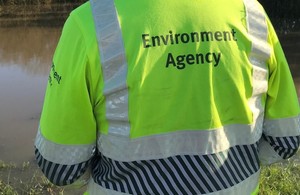Environment Agency issues Drought Permit to Yorkshire Water
The Environment Agency has issued a drought permit that will allow Yorkshire Water to reduce how much water is released from the Grimwith Reservoir.

The Environment Agency has issued a drought permit that will allow Yorkshire Water to reduce how much water is released from the Grimwith Reservoir to “top up” natural flows within the River Wharfe.
The permit allows them to extract additional water from the river at Lobwood, near Ilkley, and to reduce the amount it releases into the river from Grimwith Reservoir.
The permit was issued by the Environment Agency on Friday 22 August and will last until 22 February 2026.
It will help to reduce the pressure on reservoir stocks in the short-term, as well as enabling recharge and refill quicker through the autumn and winter months. This is to protect water supplies and the environment after an extremely dry year and the declaration of drought.
River flows and reservoir levels in Yorkshire continued to recede compared to June. The unsettled wetter weather in July was not above what we would expect for the time of year and we have seen a return to drier conditions in August, with rainfall significantly below the long-term average. We are also continuing to see higher temperatures; July was the fifth warmest on record and we had the fourth heatwave of the summer in August - putting more pressure on water supplies.
Serious deficiency in water supplies
Claire Barrow, Environment Agency Yorkshire Drought Manager, said:
Despite recent rainfall in Yorkshire, this has not been enough to refill rivers and reservoirs, and water supplies continue to decline.
This permit will allow Yorkshire Water’s reservoir stocks to remain for longer, so protects that level of public supply.
We only issue a permit if we are content that there are clear plans in place to mitigate any impact on the environment, along with strong evidence from Yorkshire Water of their ongoing commitment to reduce leaks and improve water efficiency.
We will continue to work closely with Yorkshire Water as it develops the long-term solutions to protect water resources while drought conditions continue across Yorkshire.
Yorkshire moved to drought status in June
Yorkshire officially moved to drought status on 12 June 2025 following six months of below average rainfall combined with high temperatures, which affected most of the country.
Reservoir levels across Yorkshire are notably low. The exceptional shortage of rainfall this year, and the possibility of a shortage continuing over the winter, led to Yorkshire Water applying for these permits to help alleviate water supply concerns.
To reduce unnecessary use of water and protect customer supplies and the environment, Yorkshire Water’s customers have been subject to a Temporary Use Ban (TUB) since 11 July amid a prolonged spell of warm and dry weather in the UK.
If Yorkshire Water use the drought permit for the River Wharfe they will need to inform the Environment Agency in advance. They will also need to carry out monitoring and mitigation to assess and manage potential environmental impacts.
Notes to editors
The River Wharfe at Ilkley is a designated Bathing Water. The issuing of this permit will mean a reduced amount of water in the designated bathing water.
Throughout the bathing water season, which runs from 15 May until the end of September, the Environment Agency will be testing water quality up to twenty times, per bathing water site, across Yorkshire. The results of this regular testing are used to categorise the level of water quality in bathing waters, to make it easier for swimmers to make an informed choice about where to use them.
The Environment Agency continues to take action to address the issue of poor water quality along the River Wharfe which includes:
- Working with Stakeholders in the Wharfe catchment, including the Yorkshire Dales Rivers Trust, to improve the condition of the Wharfe SSSI above Kettlewell, as well as Yorkshire Dales National Park, North Yorkshire Council, Yorkshire Water, National Trust, Natural England, Yorkshire Farming and Wildlife Partnership and other members of the Catchment Partnership for better delivery of regulation and advisory services.
- Focussing on the improvement of land management practises in the catchment through improving engagement with land managers and identification of potential projects such as soil aeration demonstration events. This aims to encourage best practice soil management which in turn will improve water quality and slow the flow.
- Targeting of EA Agricultural Officer repeat inspections of farm holdings where compliance issues have been identified, prioritising those catchments where evidence shows an impact on water quality from agriculture.
- Compliance inspections, including a review of performance and data review, of all Yorkshire Water assets upstream of Cromwheel bathing water.
- Compliance inspections of Permitted Private discharges, including trade discharges and tourist sites alongside an educational campaign promoting best practise for businesses and properties with private sewerage provision throughout the catchment.
- Further investigations to assess potential misconnections and other sources of pollution on tributaries within the vicinity of the Cromwheel including Old Wives Gill, Crabtree Gill, Mill Ghyll, Lumb Gill, Spicey Beck and Middleton Beck.
- Assessment of the impact of the introduction of ultraviolet (uv) treatment system at Grassington, Beamsley and Draughton on bacterial load into the River Wharfe.
- Reduction in the number of storm overflow operations as part of Yorkshire Water investment in sewerage infrastructure on the Wharfe catchment, particularly those local to Addingham and Ilkley.
- Assessment of feasibility of the implementation of Sustainable Urban Drainage System (SuDS) to Mill Ghyll and Spicey Beck as well as into existing infrastructure, particularly in urban areas such as Ilkley, to divert urban surface water runoff prior to entering the main Wharfe.
To find a regularly monitored water near you check out our dedicated website, Swimfo. For more information on staying safe when using and enjoying any open water, head to Swim healthy - GOV.UK